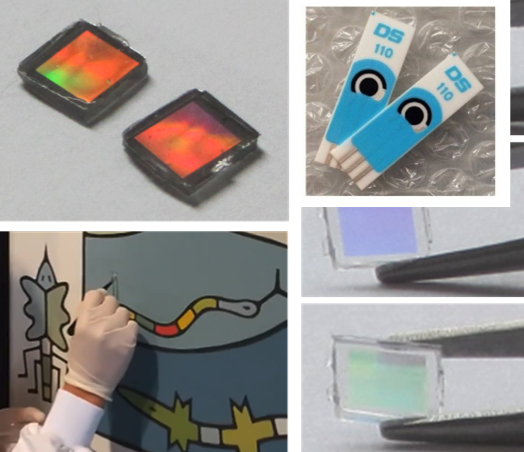WP5 - New disposable sensors
Conservative challenge
WP5 addressed the development of nanostructured substrates and sensors for the enhanced detection of diagnostic degradation products from modern and contemporary cultural heritage artifacts, and for the identification of components present in very small quantities e.g. faded inks and dyes. This is crucial for understanding the early stages of rapid and irreversible deterioration processes of artifacts, which is the case for modern and contemporary cultural heritage. Examples include the detection of degradation products of modern painting techniques based on synthetic binders (acrylics, vinyl, alkyds) and of the volatile organic compounds (VOCs) emitted from plastics and other contemporary art materials (including rapid prototyping materials) either during storage or exposition.
Formulations
- 4 metal nanoinks and nanopastes for performing Surface-Enhanced Raman Spectroscopy (SERS): these were developed for the detection of dyes, which is challenging with conventional tools.
- 3 SERS substrates: substrates for SERS were developed, including elastomers, hydrogels, and glass. These allow the direct, minimally invasive detection of dyes directly from works of art and/or the minimally invasive sampling of minimal amounts of matter from works of art, to be analyzed by SERS
- 3 VOCs sensors: electrochemical sensors were developed for convenient detection of gaseous formaldehyde, ketones, and phenols, which can be used as marker molecules for material degradation. Some are also indoor pollutants.

Innovation
The diagnostic tools developed by the project (SERS probes, sensors for VOCs detection) exhibit enhanced detection limits and more specificity/sensitivity than traditional detection techniques. SERS was found to be a more effective way to identify dye components in commercial inks than normal Raman. In some cases, SERS probes were validated and optimized so as to guarantee minimally invasive sensitive detection.
Electrochemical sensors provide a very useful approach to VOC analysis. They represent a simple, robust and inexpensive tool that can be used for a wide variety of target analyses and have scope for miniaturization and rapid analytical responses. However, their use for analysis of VOCs from heritage artifacts had not been explored before NANORESTART; in the project, the detection of specific volatile degradation markers from plastic found in museum artifacts was accomplished.
How do they work?
The two approaches proposed consist of: 1) in situ investigation of artistic materials and degradation products using the novel SERS substrates; 2) environmental detection of degradation products using novel electrochemical sensors. The newly developed sensors have been shown to successfully detect selected gaseous aldehydes such as formaldehyde and benzaldehyde and gaseous ketones such as acetone and butanone and gaseous phenol(s).
How are they applied?
For SERS probes different approaches were used: a) metal nanopastes and nanoinks were deposited on analytical surfaces constituted by ink-colored paper and analysis was perfomed in situ; b) SERS surfaces were applied directly on artwork surfaces and SERS was performed in situ; C) silicone sample strips were brought in contact with the artwork surface in order to perfom microextraction of analytical material, which was subsequently transferred to the SERS substrate and analyzed.
VOCs sensors can be placed in different positions around plastic objects and are an entirely non-invasive detection method.
Case studies and application
These systems have been used to non-invasively analyze modern and contemporary artifacts, such as lines on paper obtained from felt tip pens belonging to Federico Fellini, contemporary drawings from French artist Anne-Flore Cabanis, Japanese woodblock prints and plastic sculptures.






